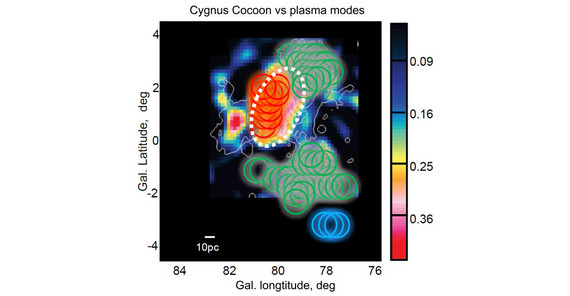Plasma is often referred to as the fourth state of matter, much more abundant than solid, liquid or gas. Stars consist predominantly of plasma – and thus nearly 90% of the visible matter in the Universe. Magnetohydrodynamic processes and plasma instabilities in astrophysics are the fundamental properties of the space plasma.
With the novel method Signature from Polarization Analysis (SPA), Prof. Dr. Huirong Yan and her team observed the composition of plasma modes in the interstellar medium. SPA links the synchrotron polarization properties to different plasma modes. Synchrotron polarization arises from electrons, moving close to the speed of light in magnetic fields. Such setup can be realized at DESY (Deutsches Elektronen-Synchrotron) which is one of the world’s leading accelerator centers and one of Prof. Yan’s places of work.
In particular, Prof. Yan and her team analyzed the polarization data from the Cygnus X region and a region near the Rosette Nebula, known for massive star formation and supernova remnants in our galaxy. They found various plasma modes in these regions, with different dispersion relations and characteristics. This discovery clearly points out the diversity of interstellar turbulence as caused by the difference in turbulence driving mechanism and local environments, invalidating the single mode assumption that is common in studies involving astrophysical turbulence. More excitingly, a high degree of consistency is found between the plasma modes they detected and a region of intense gamma-ray emission discovered by NASA’s Space Telescope Fermi-LAT (see image). The unveiled consistency points to the key role of magnetosonic turbulence in cosmic ray transport.
Huirong Yan is jointly appointed professor with the Deutsches Elektronen-Synchrotron (DESY), a Research Center of the Helmholtz Association in Zeuthen. She leads the Plasma Astrophysics group at the University of Potsdam. With her group she is exploring the basic processes in the large-scale plasma, which is closely linked to many astrophysical phenomena ranging from our solar system to the early universe.
Link to publication: Zhang, H., Chepurnov, A., Yan, H. et al. Identification of plasma modes in Galactic turbulence with synchrotron polarization. Nat Astron (2020). https://doi.org/10.1038/s41550-020-1093-4
Image caption: Turbulence modes identified in the Cygnus X region plotted over the Fermi-LAT gamma-ray map. The color code for signatures: Green - alfvenic; Red - magnetosonic; and Blue - isotropic turbulence. The distance of the object is 1.4 kiloparsec. The radius of the eddy is ~ 15 parsec (1 parsec = 3.26 light years). Image credit: Zhang et al. 2020 Nature Astronomy
Contact:
Prof. Dr. Huirong Yan, Professor of Plasma Astrophysics, E-Mail: huyanuuni-potsdampde, Phone: +49 (0) 331 977-2178
Media information 26-05-2020 / No. 060

